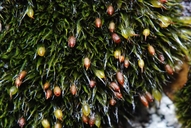- Map Distribution
- Description
- eFlora Distribution
- Illustrations
- Cal Photos images
- Elevation by latitude plot
MAP CONTROLS
1. You can change the display of the base map and layers by clicking on the layer control box in the upper right-hand corner.
2. California county polygons can be turned off and on in the layer control box.
3. Filling of Jepson subdivision polygons can be turned off and on in the layer control box.
Database links
UC Specimens in the University and Jepson Herbaria Public Portal
Specimens of Grimmia montana in the Consortium of North American Bryophyte Herbaria portal (CNABH)
Grimmia montana
Plants to 1.5 cm high, in hoary green to gray-green cushions, opaque-green to nearly black below. Leaves loosely imbricate when dry, loosely erect-spreading when moist, somewhat concave but not at all keeled, to 3 mm long with the awn constituting nearly 1/2 of that length, ovate-lanceolate from a loosely sheathing somewhat expanded base, 2.5–3.5: 1. Median leaf cells in regular longitudinal rows, unistratose in the expanded base but uniformly bistratose in the limb, smooth, to 7 µm wide, isodiametric with lumens irregular but without corner thickenings. Marginal cells not differentiated. Basal juxtacostal cells elliptical, to 3: 1, to 15 µm wide, with irregularly thickened lateral walls. Basal marginal cells transversely elongate, 0.5–0.7: 1, to 15 µm wide. Costa flared at the base and filling 1/3–1/4 of immediate leaf base, narrowed and obscure above, percurrent in the somewhat acuminate awn. Costa cross-section at leaf middle broad and flattened, less than 1.5 times as thick as the adjacent leaf, with a weak abaxial band of stereids or substereids and with a single layer of larger cells on the adaxial face. Margin of leaf limb plane to incurved, entire below. Awn strongly decurrent with its margin somewht serrulate, and with its surface spinose-prorate. Axillary hairs to 100 µmµmlong, with 6–8 nearly isodiametric and thick- walled cells, without a basal brown cell. Rhizoids red brown, to 15 µm wide at base, smooth. Stem cross-section rounded-triangular with a large and well-defined central strand, and with leptodermous, hyaline and large inner cortical cells, and with the 1–2 cell-thick outer stereome composed of much smaller, thick-walled cells strongly pigment with yellow to yellow-brown.
Dioicous with male and female plants similar. Perichaetial leaves loosely sheathing base of seta, somewhat larger and with a relatively longer, less decurrent awn than the adjacent vegetative leaves. Seta to 2.5 mm long, yellow to pale brown, straight and smooth. Urn erect, symmetrical, smooth to lightly wrinkled when dry, to 1.2 mm long, 1.5–2: 1, not strumose. Operculum short rostrate, about 1/3 as long as urn. Annulus formed of 2–3 rows of relatively more thin-walled cells. Calyptra mitrate, covering about 1/2 of urn. Peristome red-brown, to 200 µm. long, cribrose along median line near the apex, papillose to vertically striate-papillose. Exothecial cells to 25 µm. wide, not in regular vertical rows, quite irregular in size and shape, rectangular 2–4: 1, rather thick walled. Stomata phaneroporous, restricted to base of urn. Spores smooth, to 12 µm.
Catalog Notes: Many specimens attributed as G. montana in earlier references for California are actually G. ungeri according to Muñoz.
Vouchers: Fresno Co.: between Boulder Creek and Boyden Cave, Sequoia National Forest, Shevock & York 13644 (determined by Muñoz); Glenn Co.: St. John Mountain, Mendocino National Forest, Shevock & Toren 20962 (confirmed by Muñoz); Madera Co.: Nelder Redwood Grove, Sierra National Forest, Shevock & Kellman 19611 (determined by Muñoz); Santa Cruz Co.: Quail Hollow Ranch, Kellman 1142 (CAS); Tulare Co.: Elk Creek near Potwisha Campground, Middle Fork Kaweah River, Sequoia National Park, Shevock, Norris, & Barahona 13183.
Literature: Bourell 1981; Brandegee 1891; Flowers 1973; Harpel 1980a; Harthill et al. 1979; Holmberg 1969; Kellman 2003; Koch 1950a, 1951e, 1958; Koch and Ikenberry 1954; Lawton 1971; Lesquereux 1868; Lesquereux and James 1884; Long 1978; Muñoz 1998b; Shevock and Toren 2001; Showers 1982; Sigal 1975; Spjut 1971; Strid 1974; Toren 1977; Watson 1880; Yurky 1990, 1995.
Geographic subdivisions for Grimmia montana: CaR, CW, NW, SN. |
Illustration References: Malcolm et al. 2009 p. 66; Greven 2003; Lawton 1971; Muñoz 1998b, 1999a; Smith 1978.






